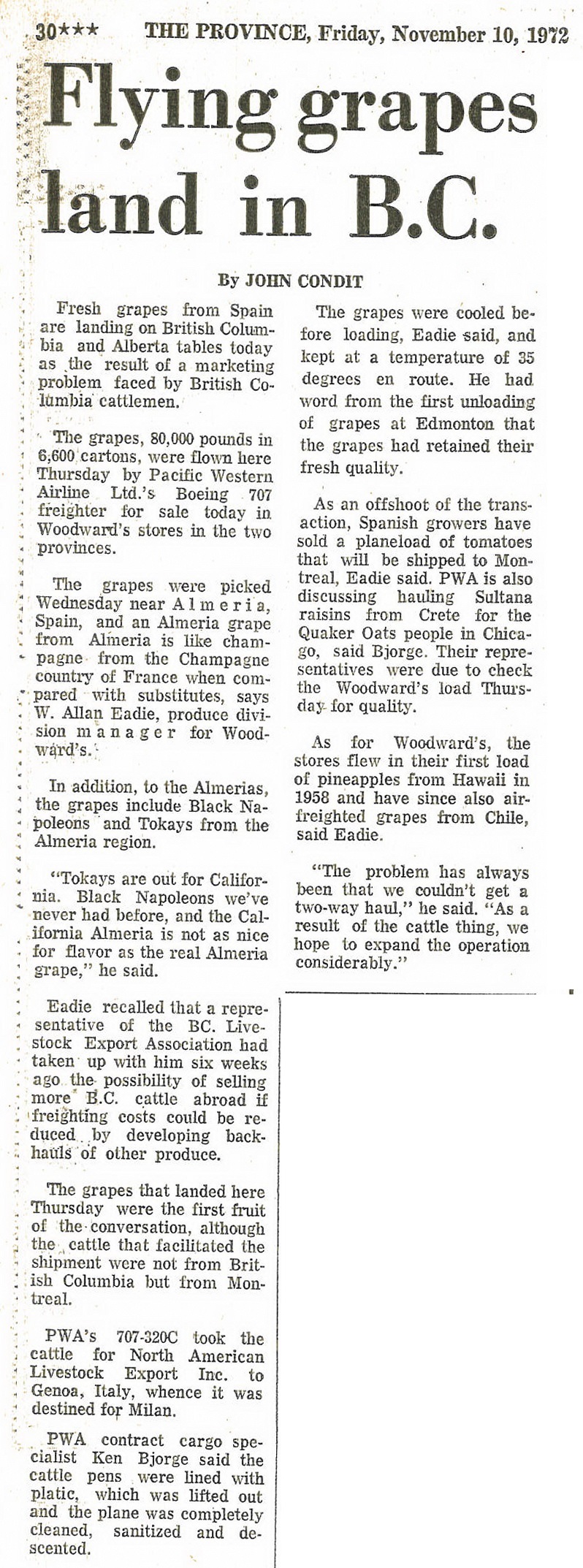While working with archival documents it is always of interest to look at the other side of the page.
In today’s example, A person needed to publish several legal notices in the local paper.
Luckily, the entire newspaper page was submitted.
The following article appeared on the back of the page (The Province [Vancouver], Friday, 10 November, 1972.)

It describes how Pacific Western Airlines was able to ship live beef to Europe, because its cargo plane could return with a cargo of grapes which were now available throughout BC and Alberta.
The article also explains how the plane was cleaned, presumably before the grapes were loaded on to the plane.
The Wikipedia page for PWA mentions the following:
Boeing 707 equipment was added to the fleet in 1967… The addition of a cargo model Boeing 707 meant that livestock and perishables could now be carried all over the world, and the name Pacific Western became synonymous with “World Air Cargo”. The company aircraft visited more than 90 countries during this period of time.
Pacific Western operated a worldwide Boeing 707 cargo and passenger charter program until the last aircraft was sold in 1979.
This is in the era where container shipping was beginning its world wide adoption.
Air cargo was expanding during this time as well, when “Boeing launched the four engine 747, the first wide-body aircraft” in 1968.
As the newspaper report explains, transportation of people and goods only makes sense if the airplane is loaded to maximum capacity at all times.
This was the thinking behind the Triangular trading system of the 19th century.
Moving people extended this thinking to modern day hub airports such as Toronto Pearson, London Heathrow and Dubai UAE.
Even today with airplanes that can travel half way around the world, the take off and landing locations are the national hub airports.
Air cargo has undergone the same thinking.
In the 1972 news report, it only made sense to Pacific Western Airlines to undertake this one-off trip once the entire route was fully booked.
The article goes on to describe how the airline was looking for other opportunities. They recognized the potential, but the tipping point (the development of an airport hub for cargo) had not yet arrived.
To see what kind of completion PWA would face today simply go to an airplane tracking app and filter for FedEx planes, or track the Memphis airport.
UPS has a similar hub in Louisville. Here is an example of one airplane in the UPS fleet that revisits the hub city regularly. This particular plane left Louisville on 28 May 2017 and travelled around the world via Honolulu, Hong Kong, Dubai, Cologne, and Philadelphia, before returning to Louisville three days later.
When you read this article, there will probably be more recent examples of round the world trips or forays to Asia or Europe before returning to it’s home base.
The article does not quote anyone from the BC Livestock Export Association, however Europe is again front of mind for the Cattlemen’s Association.
Mr. W. Allan Eadie produce manager for Woodward’s, and PWA cargo specialist Ken Bjorge would be impressed!
As Mister Eadie says in the report, he hoped that this operation would expand because of “this cattle thing.”
He and Mister Bjorge may have failed to realize that the problem was not to solve the “cattle thing.” They needed to solve the “hub thing.”
On a side note, The Imax movie “Living in the Age of Airplanes” has an excellent section on the transportation of flowers that is well worth the price of admission.
PWA purchased CP Air to form Canadian Airlines International in 1987.
Canadian Airlines has the distinction of being the first airline in the world to have a website on the Internet (http://www.cdnair.ca/).
It merged with Air Canada in 2001.


